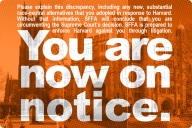You have /5 articles left.
Sign up for a free account or log in.
The University of Wyoming, rejecting criticism, this month announced that it is sticking with its new marketing campaign. The tagline: "The World Needs More Cowboys."
Critics questioned whether the term included women. After all, the university calls its men's sports teams Cowboys, but its women's teams are Cowgirls. And then there is the question of whether the cowboy image (to some) doesn't just suggest rugged individualism, but white male rugged individualism -- in ways that might seem negative or exclusionary to Native Americans and others.
Laurie Nichols, the president at Wyoming, issued a statement in which she said that “cowboys” was a term far more inclusive than critics suggest. “Drawing upon Wyoming’s proud heritage, this campaign redefines what it means to be a Cowboy in this day and age, distilling it down to the inner spirit of curiosity and boldness that all who call themselves Cowboys and Cowgirls can identify with -- no matter their race or gender, or whether they’re students, employees, alumni or other supporters,” she said. “The Cowboy spirit is what the University of Wyoming helps instill in students, giving them the skills and support they need to make the breakthroughs that benefit our state and the world.”
A video released as part of the campaign emphasizes that cowboys may be found among all genders, races and ethnicities, and promotes the modern cowboy idea as being about challenging conventional wisdom and being a trailblazer, not rounding up cattle.
The university is currently seeking more out-of-state applicants, and it tested the video with a national sample of high school students who are planning to enroll at a four-year college or university. Wyoming found that the video increased the odds of those students saying that they would apply to Wyoming. The survey found positive reactions to the university, after viewing the video, from all racial and ethnic groups. And the university said that female students were more likely than male students to say that the video increased the odds that they would apply.
"Admissions Insider" asked several experts on admissions marketing for their thoughts on the campaign -- and how to balance issues related to a state's heritage with inclusiveness.
The responses included criticism, cautions and admiration.
John Lawlor, founder of the Lawlor Group: A college or university should strive for a brand identity that communicates its authentic differentiators in order to send a signal as to who is a good fit there. So, it makes sense that the University of Wyoming would want to draw upon its state’s traditional spirit of restless exploration to indicate what the place and its students are like. But using the word “cowboy” as shorthand to viscerally evoke that spirit takes it beyond a simple indication of a niche to instead egregiously signal noninclusiveness. First impressions create lasting impressions, so even though a conscious effort appears to be made to offset the gender specificity of the word with visual content that is more inclusive, this campaign thematic will most likely be a catalyst for many prospective students to “saddle up” and explore other colleges and universities.
Gil Rogers, vice president of marketing and strategy at PlatformQ Education: As with any admissions or marketing or rebranding campaign, institutions serve multiple audiences. On one hand, an institution may be seeking to reinvent itself to stay relevant to a younger audience. On the other, institutional leadership may seek to respect a legacy as to not alienate alumni. The recent conversation around the University of Wyoming is an interesting scenario because while both of those factors are in play, the marketing team is working in an era of raised sensitivity to inclusiveness.
I can respect what the marketing team is attempting to do by redefining the term “cowboy” and making it more of an identity and a mind-set over a gender or ethnic role. With that said, I would love to understand the audience they surveyed that led them to the conclusion that this campaign was the right direction. Ultimately with many marketing campaigns there is the decision between safe and risky. They for sure chose the latter.
Peter Farrell, managing director and senior principal, Enrollment Services at EAB: The University of Wyoming campaign is a reflection of the growing investment -- even for flagships -- in identifying and furthering a unique marketing message that resonates with prospective students. Public and private institutions alike are responding to increased competition driven in part by changes in how students are choosing schools. EAB research and surveys show that students are increasingly interested in value or return on education, in some cases even more so than ranking or reputation. This shift in what students want creates an environment where even well-known schools are forced to do more to make their case.
What’s also important here is that to overcome those same challenges -- to increase diversity [and] academic quality, and grow enrollments overall -- schools need to look to traditionally underrepresented student populations. It remains to be seen whether the Wyoming campaign achieves the first goal without endangering the second. What I do know it that we’re going to see a lot more focus on using data and multimedia channels to communicate what makes each school so special, even for schools that may not have had to be so vocal about it in the past.
Elizabeth Johnson, CEO and partner at SimpsonScarborough: My first reaction is … well done, University of Wyoming! The university’s marketing team, leadership, board, and external partners all deserve congratulations. They clearly engaged in a methodical process to study their brand and thoughtfully develop a brand strategy and campaign that leverages the unique location and history of the institution. They’ve effectively captured the spirit, culture and personality of the institution, which is exactly what effective branding aims to do. Anyone that is reacting negatively is knee-jerking against the use of the word “cowboy” without even listening long enough to understand that the University of Wyoming is redefining the word. They aren’t using stereotypical images of cowboys. In this campaign, a cowboy has “restless curiosity,” “doesn’t follow predetermined paths” and “explores off the beaten trail.” Aren’t these the exact qualities we want the next generation of college graduates to exhibit? I love it and I get it. But I also work in marketing and branding.
A key component of any brand strategy is the positioning statement. Think about what that means. It means the brand is literally taking a position and communicating, "this is what we stand for." Any time a person or organization takes a position, it’s going to turn some people on and some people off. That’s not a bad thing. That’s how we decide which brands we want to associate with. Great brands attract and repel. If someone doesn’t like the message University of Wyoming is sending, they won’t apply to the school. Those who find the message compelling will. But, if University of Wyoming has a weak positioning and communicates no message at all or a generic one that sounds like every other school, no one has a reason to apply. Brands that try to appeal to everyone appeal to no one. For some institutions, regional history or heritage doesn’t and shouldn’t play a huge role in the brand strategy. For some, it’s just not relevant. But, for others, it can and should play an enormous role. Think about New York University. Its location is essential to its brand strategy. Consider the University of Virginia; Thomas Jefferson plays a giant role in the brand. At Berry College, in Rome, Ga., the faculty and students are passionate about how and why the college was founded and why it’s still relevant today; their history is definitely essential to their brand.
My advice to University of Wyoming is work with your internal audiences to help them understand the strategy behind the campaign. The university conducted deep research to generate insights that informed the campaign. They used that to develop an emotional creative strategy that effectively differentiates the university from its peers. Work hard to get your internal audiences on board, because you need them to support it and provide lift as the campaign launches externally. To other institutions getting ready to go through a similar rebranding process, my advice is to engage internal audiences in the process early and often. Involve them in every phase of the work so that by the time you get to your brand launch, you have the support you need to launch without controversy.








